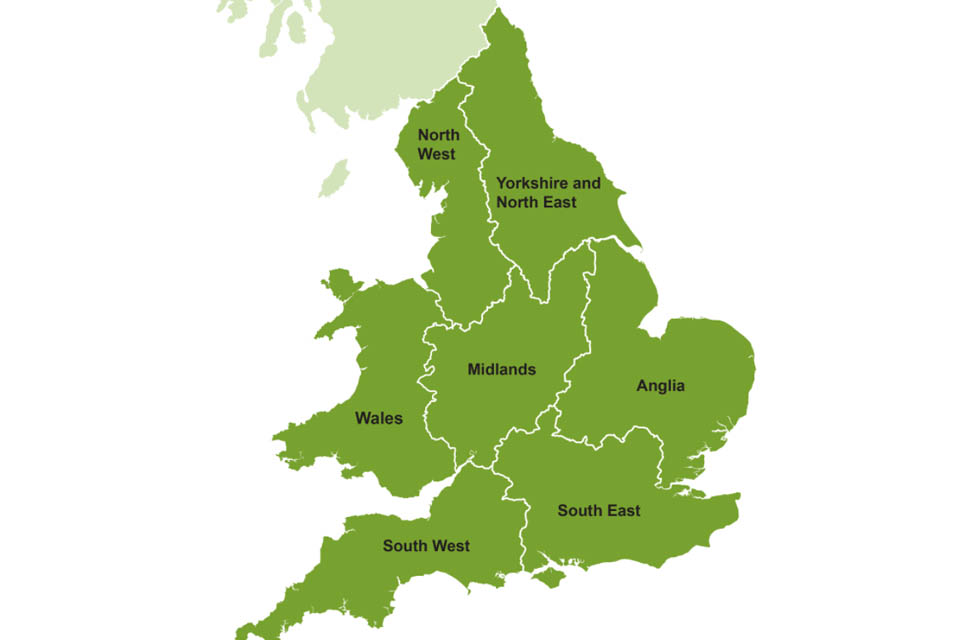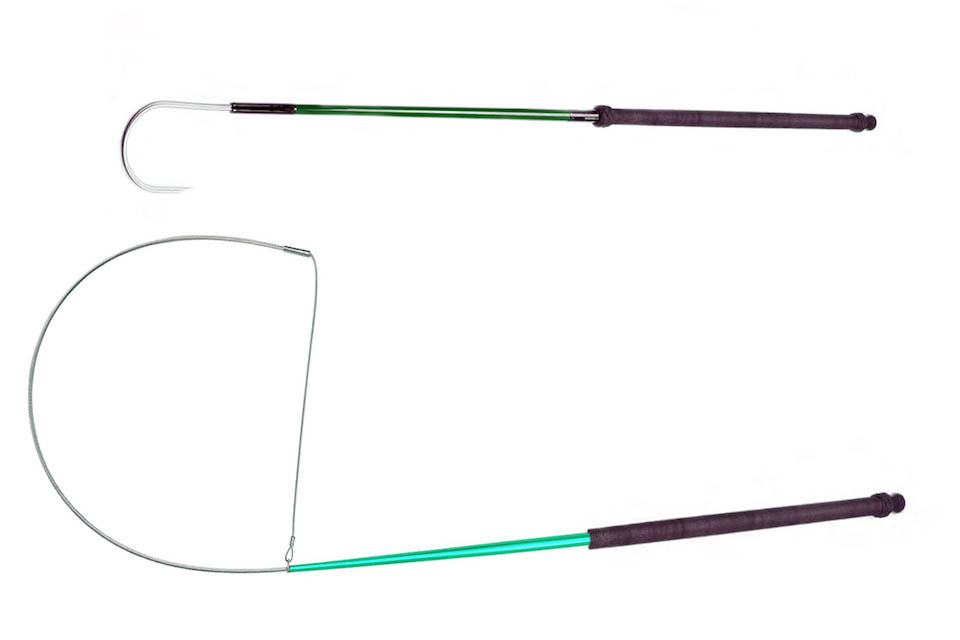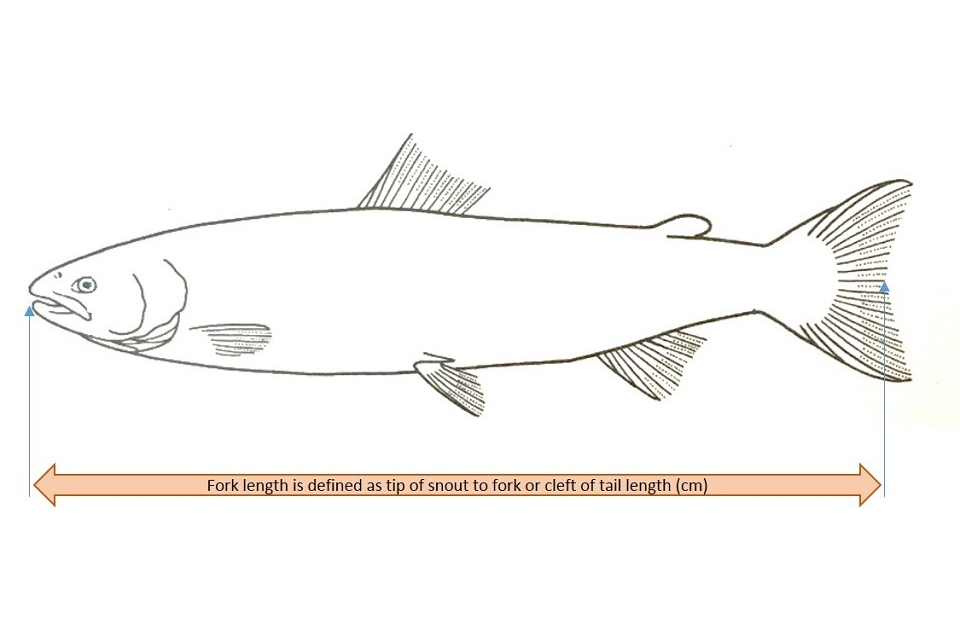National rod fishing byelaws for England: freshwater fishing with a rod and line
Rod fishing byelaws are rules and regulations explaining who can fish, where, when and what fish you can take in England.
Applies to England
Overview of national and local angling byelaws
The byelaws outlined in this guide are legally enforceable rules for freshwater fishing with a rod and line across England. National fisheries byelaws apply to all waters in England. They also apply to the Border Esk and those tributaries that are in Scotland, but exclude the River Tweed and its tributaries.
England is divided into 6 byelaw areas for angling purposes. National byelaws apply to all of these areas. Each byelaw area has its own set of supplementary byelaws.

Within these byelaw areas, some byelaws apply to the whole area, whereas others apply to one specific water or location.
You must also have permission from the fishery owner to fish and remove fish from angling club waters, private fisheries or waters on privately owned land. Be aware, fisheries may have additional rules.
If you are aged 13 or older, you must have a valid rod fishing licence to fish in England, Wales and the Border Esk. This rule also applies at private fisheries.
The supplementary byelaws for your area will tell you:
- if there are waters where you are not allowed to fish
- if start and end dates of close seasons (when you must not fish) differ from national byelaws
- which waters and species are covered by a close season
- about extra restrictions on rods and nets
- about extra restrictions on tackle, lures and bait
- about extra restrictions on size limits and catch limits
- about restrictions on fishing near specific obstacles, like weirs
If you would like more information, contact the Environment Agency helpline.
Byelaw areas
See the 6 sets of area byelaws and the locations they cover.
Anglia
The Anglia byelaw area covers all waters within river catchments flowing into the North Sea from (but not including) the River Thames catchment, to (but not including) the River Humber catchment.
Midlands
The Midlands byelaw area covers all waters within the catchments of the River Severn and River Trent, but excludes the River Little Avon (Gloucestershire) and the River Wye (Herefordshire and Gloucestershire) catchments.
North East
The North East is divided into the Northumbria byelaw area and the Yorkshire byelaw area.
The Northumbria area covers all waters within river catchments in England that flow into the North Sea northwards from Boulby Craggs (Whitestones), but does not include the River Tweed or any of its tributaries.
The Yorkshire area covers all waters which drain into, or are within the catchment, of the rivers Swale, Ure, Nidd, Wharfe, Derwent, Hull, Esk, Aire, Calder, Don, Rother and Ouse. It also includes waters to the north of the River Humber and all other waters which drain directly into the North Sea between Staithes (near Whitby) and Spurn Head.
North West and the Border Esk
The North West and the Border Esk byelaw area covers all waters within river catchments flowing into the Irish Sea northwards, from and including the River Mersey catchment (including the River Weaver and River Gowy catchments), to and including the Border Esk catchment.
South East
The South East byelaw area is divided into the Thames byelaw area and the Southern byelaw area.
The Thames area covers all waters within the River Thames catchment. It includes the River Darent and River Cray catchments, but excludes the River Medway catchment.
The Southern area covers all waters within river catchments that flow into the English Channel, from Highcliffe in Dorset in the west, eastwards to the Thames Estuary. It includes the Isle of Wight and River Medway catchments, but excludes the River Darent and River Cray catchments.
South West
The South West byelaw area is divided into the Wessex byelaw area and the Devon and Cornwall byelaw area.
The Wessex area covers waters within river catchments that flow into the:
- Bristol Channel or Severn Estuary from Foreland Point, eastwards to Newtown (Sharpness)
- sea along the south coast from Lyme Regis (excluding the River Lim), eastwards to Highcliffe, Dorset
The Devon and Cornwall area covers all waters within river catchments that flow into the sea on the south coast from Lyme Regis (including the River Lim) to Land’s End, and from Land’s End to Foreland Point on the north coast.
There are also specific byelaws for:
- Wales which also cover the parts of the River Dee and River Wye in England
- Scotland
- Northern Ireland
Why we have byelaws
These byelaws protect and improve freshwater fish and their habitats.
If you do not comply with them, you could face prosecution and be fined up to £50,000.
Call our incident hotline if you see people fishing illegally, pollution incidents, or dead or distressed fish.
Environment incident hotline
Telephone (24 hour service) 0800 80 70 60
Before you can fish: buy a rod fishing licence
Before you go fishing in England and Wales, you must buy a rod fishing licence. Licences for children between 13 and 16 years old are free. Children under 13 do not need a licence.
You can buy 1-day, 8-day and 12-month licences for:
- trout and coarse fish using 1, 2 or 3 rods
- salmon and sea trout using 1 rod
See the section on use of rods for restrictions on the number of rods you can use at any one time in different waters.
When and where you can fish
Close seasons
A close season is the period each year when certain types of fishing must stop to allow fish to breed.
Close seasons apply to rivers, streams, canals, drains and stillwaters.
All close season dates in these byelaws are inclusive. This means a stated period, such as 15 March to 15 June, includes the full day of 15 March and the full day of 15 June.
Some angling clubs and private fisheries may make their own close season rules, for example to:
- put one in where there is no statutory close season
- extend the statutory close season
They cannot remove or shorten the statutory close season.
Coarse fishing close season
The annual close season for coarse fishing is 15 March to 15 June. It applies to:
- all rivers, streams and drains
- most stillwaters that are sites of special scientific interest (SSSIs)
- some canals
- most waters in the Norfolk and Suffolk Broads
See each byelaw area for more detail.
There is no close season in the majority of stillwaters (lakes, reservoirs and ponds and most canals). Some canals are canalised rivers, so a close season will be in place. The 5 byelaw areas that have canalised rivers or stillwater SSSIs (or both) are:
Fishing for eels during the coarse fishing close season
You can fish with a rod and line for eels all year in waters with no coarse fishing close season. You must return any eels you catch, including in coastal waters, to the same water unharmed.
See the additional byelaws for eels and shad (some cover fishing during the coarse fishing close season) in:
Close season for salmon, sea trout, brown trout, rainbow trout and char
You must check the relevant byelaw area for close seasons for salmon, sea trout, brown trout, rainbow trout and char. Close seasons may differ across areas and by river.
Area close season rules may affect catch limits, size limits, types of lures and bait, days of the week and hours of the day.
See the additional close season byelaws for salmon and sea trout in:
- Anglia
- Midlands
- North East (Yorkshire)
- North East (Northumbria)
- North West and the Border Esk
- South East (including Southern and Thames)
- South West
Fishing for brown trout in stillwaters
You can fish all year with a rod and line for brown trout in fully enclosed stillwaters. A fully enclosed stillwater is one which a fish cannot swim into or out of.
There are brown trout close seasons in stillwaters that are not fully enclosed.
Fishing for rainbow trout
You can fish all year with a rod and line for rainbow trout in all stillwaters.
The rainbow trout close season in rivers, streams and drains is the same as for brown trout.
Weirs and obstacles where you cannot fish
There are no national byelaws for fishing near weirs, but there are some area and local byelaws. They refer to places above or below specific weirs, or other obstacles, where fishing is not allowed.
The following areas have specific byelaws for weirs and obstacles:
For a list of places to fish in England and Wales, visit the Angling Trust website.
Tackle, lures and bait
Types of tackle, lures and bait you must not use
You can fish with up to 4 rods and lines. It depends on what you are fishing for and where (see the section on use of rods).
You can use a landing net to help you land your fish.
You must not use a gaff (pictured), tailer (pictured), firearm, otter lath, wire, snare, crossline, setline, spear, stroke-haul, snatch or light.

You must get authorisation from the Environment Agency to use any other fishing methods and instruments.
Foul hooking
You must immediately release any salmon, sea trout, trout or freshwater fish you catch by foul hook from a river, stream, drain or canal.
A foul hook is when a hook catches in the body or fin of a fish, or anywhere other than the mouth or throat.
Keepnets, keepsacks and landing nets
You must not use any keepnet:
- with knotted or metallic mesh
- less than 2 metres in overall length
- with holes in the mesh larger than 25mm in circumference
- with supporting rings or frames more than 40cm apart (excluding the distance from the opening to the first ring or frame)
- with rings less than 120cm in circumference
You must not use any keepsack:
- made from anything other than soft, dark coloured, non-abrasive, water-permeable fabric
- less than 120cm x 90cm (if rectangular), or 150cm x 30cm x 40cm (if used with a frame)
You must not:
- hold more than one fish in a single keepsack.
- use landing nets with knotted or metallic mesh
You may be fined if you leave fish in a keepnet or keepsack after you have finished fishing.
Use of rods
You must not fish:
- for salmon, trout, sea trout and char on rivers and streams using more than 1 rod and line at the same time
- for salmon, trout, sea trout and char on reservoirs, lakes and ponds with more than 2 rods and lines at the same time
- for coarse fish or eels with more than 4 rods and lines at the same time
- with more than 4 rods and lines in total at the same time
When you fish with multiple rods and lines, you must place each rod close together so that the total distance between the outermost fishing rods does not exceed 3 metres.
It is illegal to leave a rod and line unattended with its bait or hook in the water. You must be in control of your rod and line at all times.
Rods not affected by licence limits
The rods not affected by licence limits (unless they have hooks attached) are:
- spod rods (used to propel bait into water)
- marker rods (used to mark out lines)
Bait and lures
You must only use artificial fly or artificial lure when fishing for salmon before 16 June in any year.
You must not use crayfish, dead or alive, as bait or in bait.
You can use live bait (using small fish to catch bigger fish) providing you keep the bait fish at, and only use them in, the water you took them from. Please note, some local byelaws do not allow this.
You must get written agreement from the Environment Agency to transfer any fish or fish spawn from one water to another. You must keep to any conditions imposed in that written consent.
Lead weights
You must not use any form of lead weight attached to a fishing line, other than those of 0.06g (size 8) or less, or of more than 28.35g (1 ounce).
This does not include lead in a weighted line, swim-feeder or fishing fly or lure.
Dispose of your tackle safely to avoid harm to wildlife.
Catch limits, size limits and catch returns
There are limits on the number, size and type of fish you can catch and keep. You must return fish you cannot keep to the water unharmed.
You must also have permission from the fishery owner to fish and remove fish from angling club waters, private fisheries or waters on privately owned land.
Daily catch limit for coarse fish
The daily catch limit applies to all rivers, streams and drains. These limits also apply to the following canals and stillwaters:
- Aire and Calder Navigation (Castleford Weir and Ferrybridge Lock)
- Stroudwater and Thames Canal
- Fossdyke Canal
- Kennet and Avon Canal downstream of the confluence with the River Kennet at Kintbury
- Lee Navigation upstream of Aqueduct Lock
- all waters within the Norfolk Broads
- Windermere
- Coniston Water
- Ullswater
- Derwentwater
Each day, you can take:
- a total of 15 coarse fish (barbel, chub, common bream, common carp, crucian carp, dace, perch, pike, roach, rudd, silver bream, smelt or tench, including any hybrids of these species), other than grayling, of not more than 20cm
- 2 grayling sized between 30cm and 38cm
- 1 pike of not more than 65cm
You can also take the following fish from rivers, streams and drains:
- non-native species
- ornamental varieties
- minnow
- loach
- bleak
- gudgeon
- bullhead
- stickleback
- ruffe
You need permission from the owner to remove fish from stillwaters and canal fisheries. You must return eels or shad to the same water unharmed.
You must return fish that are not legal to keep, to the same water with as little injury as possible.
You must return fish not legal to keep, that you kept in a keepnet or keepsack, alive to the same water before or when you complete fishing.
You may be fined if you leave fish that are not legal to keep in a keepnet or keepsack after you have finished fishing.
If you catch fish to use as live bait, you must keep them at, and only use them in, the water from which you took them (except where local byelaws do not allow this) - see the section on bait and lures.
You measure the size of a fish from the tip of the snout to the fork or cleft in the tail.

Catching and keeping salmon
It is illegal to catch and remove any live or dead salmon from any waters or banks before 16 June (or later, in some local byelaws) in any calendar year. All salmon caught before 16 June must be released immediately with the least possible injury.
Before 16 June, you can only fish for salmon with rod and line using an artificial fly or artificial lure. You must return all catch unharmed.
It is illegal to sell, or keep with the intention of selling, any salmon or sea trout that has been caught with a rod and line.
You can be fined for selling rod and line-caught salmon or sea trout.
Supplementary byelaws on daily catch limits for salmon and sea trout
See the supplementary byelaws on catch limits for salmon, sea trout and char in the:
Salmon and sea trout: reporting your catch return
A catch return is a record of an angler’s annual salmon and sea trout fishing.
You need the correct licence to fish for salmon or sea trout.
If you hold a salmon and sea trout licence, you have a legal responsibility to submit a catch return, even if you did not fish. This means that you must make a record of when and where you went fishing, what you caught, and the weight of each fish.
The catch return report helps the Environment Agency understand the health and wellbeing of salmon and sea trout.
It’s a good idea to keep a notebook with your fishing tackle.
You can submit your catch return online or use the form printed on the back of your letter that accompanied your licence.
There are penalties for not completing an annual catch return report.
Updates to this page
-
Updated the links to guidance for people in Wales, Scotland and Northern Ireland.
-
Added a missing byelaw. Under the 'bait and lures' sub heading added ' you must only use artificial fly or artificial lure when fishing for salmon before 16 June in any year'.
-
Updated the section 'Catch limits, size limits and catch returns' to include: You must also have permission from the fishery owner to fish and remove fish from angling club waters, private fisheries or waters on privately owned land.
-
Updated to include new game fishing byelaws for the River Camel in Cornwall. We have also removed a time-limited byelaw on the River Lune in Lancashire which has expired. We have made other changes to make the byelaws easier to follow.
-
First published.